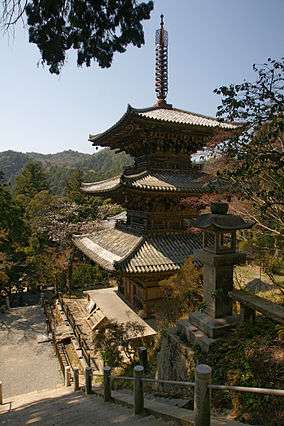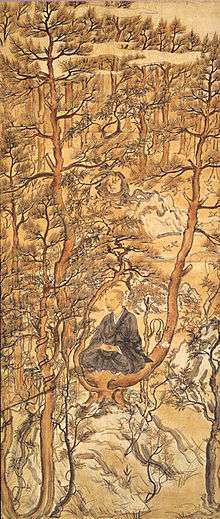Myōe
| Part of a series on |
| Buddhism in Japan |
|---|
 |
Myōe (Japanese: 明恵) (1173–1232) was a Japanese Buddhist monk active during the Kamakura period who also went by the name Kōben (Japanese: 高弁), and contemporary of Jōkei and Honen.
Life
Born into the Yuasa family (湯浅), allegedly descended from a branch of the Fujiwara clan, he came to be ordained in both the Shingon school of Buddhism and the Kegon school. In Medieval Japan it was not uncommon for monks to be ordained in multiple sectarian lineages, and Myōe alternately signed his treatises and correspondence as a monk of either school through much of his career. In the latter half of his career he served as abbot of Kōzan-ji (高山寺), a temple of the Kegon sect located near Kyoto. Myōe is perhaps most famous for his contributions to the practice and popularization of the Mantra of Light, a mantra associated with Shingon Buddhism but widely used in other Buddhist sects. Myōe is also well known for keeping a journal of his dreams for over 40 years, studied by later Buddhist scholars, and for his efforts to revive monastic discipline along with Jōkei.
During his lifetime he was a scathing critic of his contemporary, Hōnen, and the new Pure Land Buddhist movement. As a response to the increasing popularity of the exclusive nembutsu practice, Myōe wrote two treatises, the Zaijarin (摧邪輪, "Tract for Destroying Heretical Views") and the follow-up Zaijarin Shōgonki (摧邪輪荘厳記 "Elaboration of the Zaijarin") that sought to refute Honen's teachings as laid out in the Senchakushu. Myōe agreed with Hōnen's criticism of the establishment, but felt that sole practice of the nembutsu was too restrictive and disregarded important Buddhist themes in Mahayana Buddhism such as the Bodhicitta and the concept of upāya. Nevertheless, Myōe also lamented the necessity of writing such treatises: "By nature I am pained by that which is harmful. I feel this way about writing the Zaijarin." (trans. Professor Mark Unno)

In the later years of his life, Myōe wrote extensively on the meaning and application of the Mantra of Light. Myōe's interpretation of the Mantra of Light was somewhat unorthodox, in that he promoted the mantra as a means of being reborn in the Pure Land of Amitabha Buddha, rather than a practice for attaining Enlightenment in this life as taught by Kūkai and others. Myōe was a firm believer in the notion of Dharma Decline and sought to promote the Mantra of Light as a means
Myōe was equally critical of the lax discipline and corruption of the Buddhist establishment, and removed himself from the capital of Kyoto as much as possible. At one point, to demonstrate his resolve to follow the Buddhist path, Myōe knelt before an image of the Buddha at Kōzan-ji, and cut off his own ear. Supposedly, the blood stain can still be seen at the temple to this day. Records for the time show that the daily regimen of practices for the monks at Kōzan-ji, during Myoe's administration, included zazen meditation, recitation of the sutras and the Mantra of Light. These same records show that even details such as cleaning the bathroom regularly were routinely enforced. A wooden tablet titled Arubekiyōwa (阿留辺畿夜宇和, "As Appropriate") still hangs in the northeast corner of the Sekisui'in Hall at Kōzan-ji detailing various regulations.
At the same time, Myōe was also pragmatic and often adopted practices from other Buddhist sects, notably Zen, if it proved useful. Myōe firmly believed in the importance of upāya and sought to provide a diverse set of practices for both monastics and lay people. In addition, he developed new forms of mandalas that utilized only Japanese calligraphy and the Sanskrit script, Siddham. Similar styles were utilized by Shinran and Nichiren. The particular style of mandala he devised, and the devotional rituals surrounding it, are recorded in his treatise, the Sanji Raishaku (Thrice-daily worship) written in 1215.[1]
Myōe sought twice to go to India, in 1203 and 1205, to study what he considered true Buddhism amidst the perceived decline of the Dharma, but in both occasions, the kami of the Kasuga Shrine urged him to remain in Japan through oracle.
Monastic Regulations promulgated by Myōe

In the wooden tablet at Kōzan-ji Temple mentioned above, Myōe listed the following regulations to all monks, divided into three sections:[note 1]
As Appropriate
- 06:00 - 08:00 PM, Liturgy: Yuishin kangyō shiki (Manual on the Practice of Contemplating the Mind-Only)
- 08:00 - 10:00 PM, Practice once. Chant the Sambōrai (Revering the Three Treasures).
- 10:00 - 12:00 AM, Zazen (seated meditation). Count breaths.
- 12:00 - 06:00 AM, Rest for three [two-hour] periods.
- 06:00 - 08:00 AM, Walking meditation once. (Inclusion or exclusion should be appropriate to the occasion). Liturgy: Rishukyō raisan (Ritual Repentance Based on the Sutra of the Ultimate Meaning of the Principle) and the like.
- 08:00 - 10:00 AM, Sambōrai. Chant scriptures for breakfast and intone the Kōmyō Shingon (Mantra of Light) forty-nine times.
- 10:00 - 12:00 PM, Zazen. Count breaths.
- 12:00 - 02:00 PM, Noon meal. Chant the Goji Shingon (Mantra of the Five Syllables) five hundred times.
- 02:00 - 04:00 PM, Study or copy scriptures.
- 04:00 - 06:00 PM, Meet with the master (Myōe) and resolve essential matters.
Etiquette in the Temple Study Hall
- Do not leave rosaries or gloves on top of scriptures.
- Do not leave sōshi [bound] texts on top of round meditation cushions or on the half tatami-size cushions [placed under round cushions].
- During the summer, do not use day-old water for mixing ink.
- Do not place scriptures under the desk.
- Do not lick the tips of brushes.
- Do not reach for something by extending one's hand over scriptures.
- Do not enter [the hall] wearing just the white undergarment robes.
- Do not lie down
- Do not count [pages] by moistening one's fingers with saliva. Place an extra sheet of paper under each sheet of your sōshi texts.
Etiquette in the Buddha-Altar Hall
- Keep the clothes for wiping the altar separate from that for wiping the Buddha[-statue].
- During the summer (from the first day of the fourth month to the last day of the seventh month), obtain fresh water [from the well] morning and evening for water offerings.
- Keep the water offerings and incense burners for buddhas and bodhisattvas separate from those for patriarchs.*
- When you are seated on the half-size cushions, do not bow with your chin up.
- Do not place nose tissues and the like under the half-tatami size cushions.
- Do not let your sleeves touch the offering-water bucket.
- Do not put the [altar] rings on the wooden floor; they should be placed high.
- Place a straw mat at your usual seat.
- The regular sutra for recitation is one fascicle of the Flower Ornament Sutra (or half a fascicle). The three sutras should be read alternately every day.
- When traveling, you should read them after returning.
- The Gyōganbon (Chapter on Practice and Vow), Yuigyōkyō (Sutra of the Buddha's Last Teachings), and Rokkankyō (Sutra in Six Fascicles) should all be read alternately one fascicle a day.
— The Kegon School Shamon Kōben [Myoe]
See also
Notes
- ↑ Reprinted with permission from Professor Mark Unno from the book Shingon Refractions: Myōe and the Mantra of Light
References
- ↑ Gohonzon Shu: Dr. Jacquie Stone on the Object of Worship Archived April 29, 2007, at the Wayback Machine.
Further reading
| Wikimedia Commons has media related to Myōe. |
- Abe, Ryūichi (2002). Mantra, Hinin, and the Feminine: On the Salvational Strategies of Myōe and Eizon, Cahiers d'Extrême-Asie, Vol. 13, 101 - 125
- Buswell, Robert E., Lopez, Donald S. Jr. (2014). The Princeton Dictionary of Buddhism, Princeton University Press, p. 558
- Girard, Frédéric (1990). Un moine de la secte Kegon à Kamakura (1185-1333), Myôe (1173-1232) et le Journal de ses rêves, Paris: Ecole française d'Extrême-Orient. ISBN 285539760X
- Kawai, Hayao; Unno, Mark (1992). The Buddhist priest Myōe: a life of dreams. Venice, CA: Lapis. ISBN 0932499627
- Morell, Robert E. (1982). Kamakura Accounts of Myōe Shonin as Popular Religious Hero, Japanese Journal of Religious Studies 9 (2-3), 171-191
- Mross, Michaela (2016). Myōe’s Nehan kōshiki: An Annotated Translation, Japanese Journal of Religious Studies Volume 43 (1), Online supplement 2, 1–20
- Unno, Mark (2004). Shingon Refractions: Myōe and the Mantra of Light. Somerville MA, USA: Wisdom Publications, ISBN 0-86171-390-7